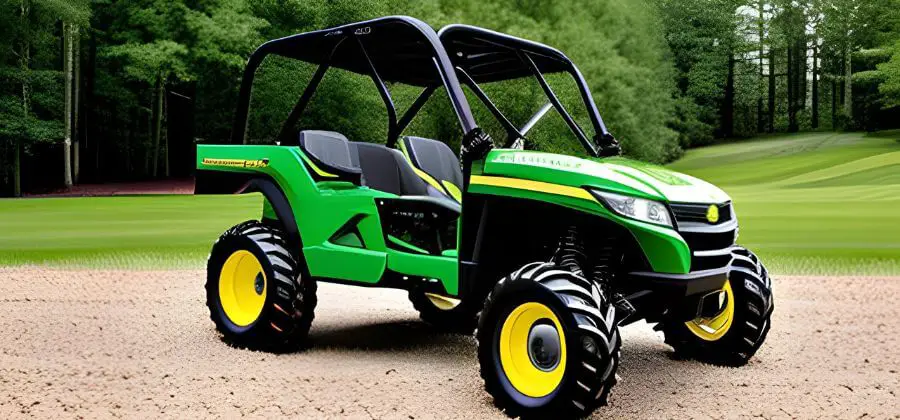If you’ve finally invested in a John Deere Gator 620i to haul equipment and supplies around your property. This versatile utility vehicle can make short work of many tasks, but like any machine, it can develop issues over time. Many common John Deere Gator 620i problems are easy to diagnose and fix yourself.
In this article, we’ll walk you through the most frequent problems these workhorses experience and the steps you can take to get your Gator back up and running. Whether it’s a dead battery, a seized brake caliper, or a sputtering engine, A few basic tools and a little mechanical know-how are all you need to troubleshoot most problems.
Common problems of John Deere Gator 620I
1) Engine Problems and Solutions
If your Gator 620i is acting up, the problem is probably in the engine. These machines are workhorses, but even the most rugged engines need some TLC now and then.
- One common issue is engine overheating. Make sure you haven’t overloaded the Gator; the recommended payload maxes out at 1000 lbs.
- An engine that cranks but won’t start could indicate a bad fuel filter or fuel pump. Replace the fuel filter first; it’s the cheaper fix, and filters need swapping every year or so anyway.
- Loud knocking or grinding usually means low oil or a dying alternator. Check your oil levels and refill or change the oil. If the noise persists, the alternator likely needs replacement. An alternator recharges the battery as you drive, so if it’s malfunctioning, you’ll also notice dimming headlights or trouble starting.
- Other issues like surging, stalling, or loss of power could be due to a clogged air filter, bad spark plugs, or ignition coils. Replacing worn-out spark plugs and ignition coils is an easy DIY fix that can get your Gator running right. If in doubt, never hesitate to have your trusted John Deere technician perform a full diagnostic.
2) Transmission Issues and Troubleshooting
If your Gator 620i is having trouble shifting gears or seems sluggish, the transmission is likely the culprit. The CVT transmission on this model requires proper maintenance and the right fluid for optimal performance.
- First, check the transmission fluid level. Locate the dipstick near the rear axle, pull it out, wipe it off, and reinsert it fully. Pull it out again to check the level. It should be in the crosshatched area. If it’s low, add John Deere Low Viscosity HY-GARDTM Transmission Oil.
- Next, inspect the drive belt. As it wears out, it can slip and cause issues. Look for fraying, cracking, or shiny spots. If damaged, have it replaced by a dealer?
- You should also change the transmission filter every 200 hours. Clogged filters reduce flow, overheat, and damage the transmission. Purchase a genuine John Deere filter kit and follow the instructions to replace it.
Other things to check include:
- Connections: Make sure all wiring, hoses, and linkages are securely connected and not damaged. Faulty connections disrupt signals and fluid flow.
- Sensors: Malfunctioning speed, throttle position, and temperature sensors can confuse the transmission and engine. Have the dealer test and replace any bad sensors.
- Solenoids: A qualified technician must replace any solenoids that are stuck or have failed and govern clutch packs and gear changes.
- Software: Outdated software may need to be re-flashed. See your dealer for the latest update to ensure proper performance.
With regular maintenance and prompt attention to any issues, your Gator’s transmission can provide years of dependable service. But at the first sign of a problem, have it checked right away. It’s much easier and more affordable to prevent damage than to repair or replace a transmission!
Electrical System Problems: Diagnosing and Resolving Issues
The electrical system in your Gator is responsible for starting the engine, powering accessories like lights and radios, and charging the battery. Several common issues can arise with the electrical system which are relatively easy to diagnose and repair yourself.
3) Faulty Alternator
The alternator charges the battery while the engine is running. If it’s malfunctioning, your Gator may suddenly lose power while operating. Check the alternator belt first—if it’s loose, frayed, or broken, it won’t properly spin the alternator. Tighten or replace the belt. Much lower, and the alternator likely needs replacement.
4) Weak or Dead Battery
A battery lasts 3–5 years on average. If your Gator won’t start or is losing power, the battery is a likely culprit. Check the battery connections first—clean and tighten if corroded. Then use a voltmeter to test the battery voltage. A reading of 12.5 volts or less indicates it needs replacement.
When replacing, get a battery matched to your specific Gator model for optimal performance.
5) Blown Fuses
Fuses protect the Gator’s electrical circuits from overload. If accessories like lights, radios, or charging ports stop working, check the fuses. The fuse panel is located under the hood or in the cab, depending on your Gator model. Pull out each fuse one by one and inspect for a burned-out or broken fuse.
Replace any blown fuses with ones with the same amperage rating to restore power. Blown fuses often indicate an underlying issue, so have the Gator serviced if the fuses continue to blow.
Following basic troubleshooting for common electrical issues will help get your Gator 620i back up and running in no time. Be sure to replace or service any faulty components to prevent further problems down the road. If issues persist, it’s best to have a John Deere-certified technician fully diagnose and repair the electrical system.
6) Worn Tie Rods
The tie rods connect the steering rack to the wheels, controlling the Gator’s direction. When tie rods wear out, you may notice the Gator pulling to one side, wandering, or becoming difficult to keep straight. Replacing the tie rods involves removing the old ones, measuring and installing new ones, and then aligning the front wheels. It’s best left to a mechanic with experience working on Gators.
7) Faulty Ball Joints
Ball joints connect the control arms to the steering knuckles, allowing the wheels to pivot. Worn or damaged ball joints can cause the front end to shake or clunk over bumps. Replacing ball joints requires removing several front-end components to access the ball joints, then reinstalling everything and aligning the wheels. Again, ball joint replacement is best done by a skilled mechanic.
8) Blown Shocks
Shocks absorb impacts and vibration, providing a smooth ride. When shocks blow out, the Gator will bounce, sway, and handle poorly. Replacing shocks involves jacking up the Gator, removing the old shocks, and installing new ones. Be very careful when working under a jacked-up Gator! Shocks can be tricky to replace for the average owner.
If your Gator 620i is showing any signs of steering, suspension, or handling issues, have it checked by a certified John Deere mechanic? Worn or broken steering and suspension components can be dangerous if not addressed promptly. Regular service and inspections, as recommended in your owner’s manual, are the best way to catch these kinds of problems early.
9) Battery Problems
If your Gator won’t start, the battery is the first thing to check. After recharging, If it still won’t hold a charge, buy a new marine deep-cycle battery as a replacement.
10) Faulty Fuses
Blown fuses can prevent the Gator from starting or certain features from working. The fuse box is located under the hood; check for any burned-out fuses and replace them. Always replace fuses with the same amperage rating.
11) Clogged Fuel Filter
Over time, the fuel filter can get clogged with debris, restricting fuel flow. Replace the fuel filter if you notice the Gator has difficulty starting, loses power when operating, or the engine sputters. Refer to your owner’s manual for the correct replacement filter and installation instructions.
12) Faulty Sensors
Problems like uneven idling, loss of power, or the Check Engine light coming on can indicate an issue with sensors like the oxygen sensor, throttle position sensor, or camshaft position sensor. Has the Gator’s computer been scanned to determine the fault code and replace any bad sensors?
13) Loose or Faulty Connections
Corrosion or damage to wire connectors, grounds, or fuse box terminals is frequently the root cause of intermittent electrical problems such as power loss to specific components, flickering lights, or other problems. Inspect electrical connections for tightness and corrosion, and clean or replace them as needed.
With regular maintenance and a bit of mechanical know-how, many minor issues with the John Deere Gator 620i can be resolved quickly without needing to take it into the shop. Performing your repairs and troubleshooting will help keep your Gator running reliably for years to come.
14) Steering and Suspension Problems
Another common issue Gator 620i owners report is problems with the steering and suspension. After years of use, parts like tie rods, ball joints, and shock absorbers can wear out, causing the Gator to wander, shake, or handle poorly.
Conclusion
The John Deere Gator 620i has the most common issues and tips on how to get your trusty sidekick back up and running. These utility vehicles are workhorses, but like any machine, problems can pop up. Luckily, many fixes are within the DIY skill set of a hands-on owner.
With some time, patience, and a few replacement parts, you’ll have your Gator hauling gear and tackling tasks in no time. And when all else fails, your local John Deere dealer’s service department can diagnose and repair any pesky gremlins in the system.
FAQs
Why won’t my Gator start?
There are a few possible reasons your Gator won’t start:
Dead battery, Faulty alternator, Bad ignition, or fuel pump.
The check engine light came on. What should I do?
The check engine light could indicate something minor. However, it’s best to have the code scanned to determine the cause. Common issues that trigger the check engine light include:
Loose gas cap, Faulty sensor, or Emissions system issue.
How quickly can a John Deere 620i move?
The XUV 620i is John Deere’s most modern, comfortable, and performance-focused utility vehicle ever made. It has true 4WD, electronic fuel injection, independent rear suspension, and a top speed of 30 mph.
Why is my Gator making strange noises?
Unusual sounds from your Gator could signal a problem with the:
1) Squealing, knocking, or grinding sounds from the engine bay requires immediate attention.
2) Clicking, popping, or grinding sounds when turning may indicate issues with the front axle or rear differential.
3) Squealing or scraping sounds when braking point to brake wear or damage.
For more mower problems and fixes visit here and for more guides related to mowers visit Mowers Guide




